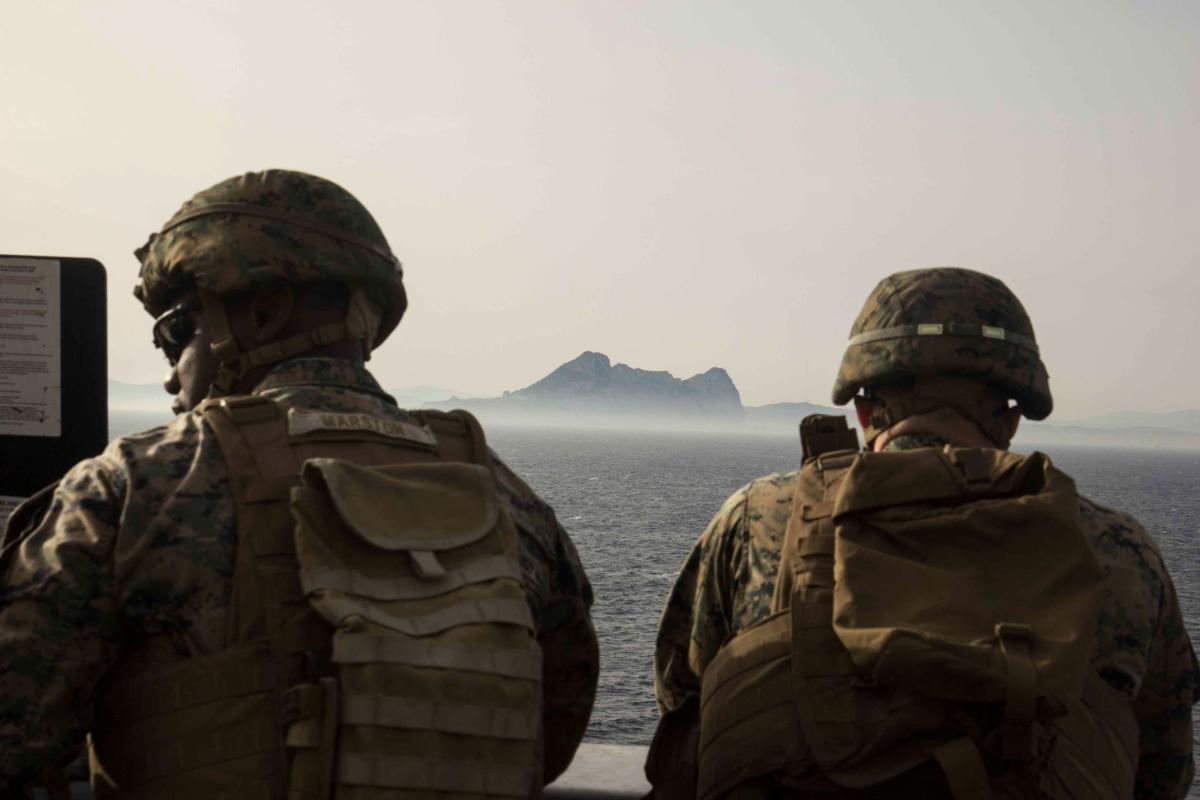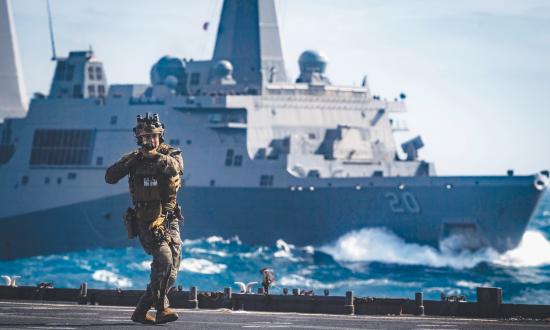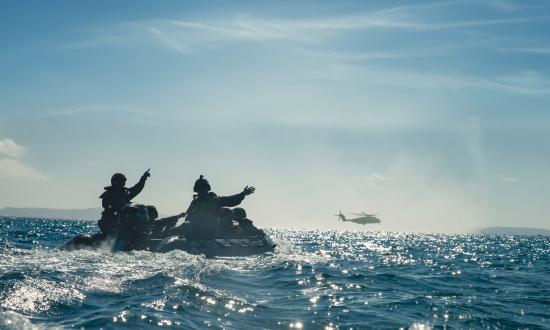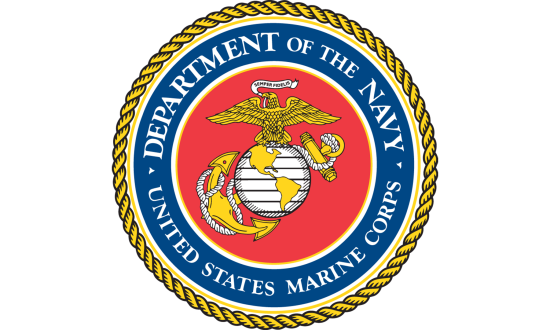The U.S. Navy’s current amphibious ship inventory is a shadow of its former self. The numbers have fluctuated through the decades: from an incredible 2,500 ships at the height of World War II, to just 60 by 1949, back up to 226 during the Korean War, down to 110 in 1961, again up to 156 during the Vietnam War, but plummeting to 64 by 1975 and gradually diminishing to 59 traditional amphibious warships by 1981. Under the extended leadership of the 65th Secretary of the Navy, John Lehman (1981–87), the Navy’s inventory of amphibious warfare ships then grew to a peak of 65 vessels.1 Since Lehman’s era, Marine amphibious lift requirements and shipbuilding objectives have diminished with changing strategic goals and competing fiscal priorities. The Navy no longer links amphibious warfare ship requirements to joint forcible entry operations; rather, it links these requirements to combatant commanders’ (CoComs’) enduring need for Marine expeditionary units (MEUs) that respond to crisis, deter adversary aggression, assure allies and partners, and contest “gray zone” activities.
If met, the current CoCom demand for MEUs would necessitate a fleet of 39 amphibious ships. If maintained at a 63 percent availability rate, those 39 ships would provide sufficient inventory for simultaneously deployed East and West Coast MEUs and the Japan-based Forward Deployed Naval Force (FDNF). However, only 31 ships remain in the current inventory. The Department of Defense’s (DoD’s) proposed fiscal year 22 budget and the associated shipbuilding plans project a further reduction to the amphibious inventory.2 While one might argue the DoD needs greater resources to close the gap, a more pragmatic view is that it needs to change its priorities with respect to amphibious capacity. Unless or until the Navy can elevate and sustain investments into traditional amphibious warfare ships, it must consider alternative concepts to posture the amphibious lift necessary to support an optimized amphibious ready group (ARG)/MEU posture. These new concepts must effectively position the resources forward to compete while decreasing response times by increasing the availability of sea-based forces crisis response forces. One approach worth exploring is a Mediterranean Forward Deployed Naval Force (FDNF).
Sustained Demand for ARG/MEUs
While the traditional amphibious warfare ship inventory has diminished, demand for the crisis-response capabilities provided by the versatile ARG/MEU team has not. In the past ten years, the nation’s ARG/MEUs have supported embassy evacuations in Yemen, recovered downed pilots in Libya, evacuated noncombatants in Afghanistan, and provided humanitarian assistance in Puerto Rico, Haiti, Pakistan, Japan, and the Philippines. They strengthened alliances and partnerships and participated in more than 100 bilateral and multilateral exercises throughout Asia, Oceania, the Middle East, Europe, and North Africa. Assessing the ongoing and future effects of COVID-19 on the economic and political stability of developing nations and the projected impacts of climate change in terms of more frequent natural disasters, population dislocations, and associated political unrest, the Navy and Marine Corps anticipate an increasing need for ARG/MEUs in the littoral regions of the U.S. Indo-Pacific Command (IndoPacom), European Command (EuCom), Central Command (CentCom), and Africa Command (AfriCom).
Insufficient Resource Prioritization
Using the current prioritization model, the Navy lacks the resources necessary to provide an amphibious inventory commensurate with the demand for MEUs for several reasons. In a resource-constrained environment, cost growth in the acquisition of frigates, carriers, and submarines challenges the acquisition of traditional L-class warfare ships. Even if the Navy were to be gifted the obligation authority necessary to remedy this gap, significant shortfalls remain that no amount of money can swiftly correct. While these are difficult decisions for the Navy, they represent just another class of ship that must be prioritized and resourced against a long list of other requirements with powerful advocates within the service. For the Marine Corps, these amphibious ships are integral to its purpose and identity—enabling strategic value while providing unmatched organic mobility and operational agility.
Considering all the Navy shipbuilding challenges, they are magnified for amphibious ships. While nuclear-powered vessels are built in private yards and maintained largely in public yards, the business of constructing and maintaining amphibious warfare ships is a private-yard endeavor and thus acutely exposed to the market forces challenging the shipbuilding industry. The gradual contraction of the U.S. shipbuilding industry has resulted in class specialization among the few remaining prime contractors that no longer possess the infrastructure capacity, human capital, or the supply chains of past years. Worse, the whipsaw volatility of the industry crushes its smaller suppliers. After receiving approval as a supplier—in some cases a three-year process—they may lose an entire line of business with changes to shipbuilding plans. The remedy is as obvious as it is unlikely—years of sustained, consistent investment into the amphibious inventory. To ensure this happens, Congress should codify the minimum number of amphibious ships required to protect the nation’s power projection capability into law.
The inevitable result of these negative trends is accelerated material degradation of the entire amphibious fleet. The effect of the combined trends of underinvestment and the atrophying industrial base increases the burden on the remaining ships.3 The demand for these ships relative to the inventory has now increased to a point in which no reserve capacity remains to compensate for unexpected maintenance casualties or no-notice crisis deployments.4 As a result, the Navy must consider a series of “least bad” choices when unexpected events occur. These choices include extending deployments, deferring maintenance, and quick-turning alternative ships to meet today’s demands. Maintenance requirements accumulate, as does the time and resources necessary to address them. Underinvestment in the amphibious battle force inventory exacerbates the bill due. When “surge” employment becomes the norm, the second order effects are unavoidable and severe. The loss of even one ship out-of-cycle, as seen with the USS Bonhomme Richard (LHD-6) casualty, drives home the razor thin margin of our current amphibious fleet.
Obscuring Demand
Past and contemporary employment models for ARG/MEUs obscure the actual demand for amphibious ships. Because of the need for coverage across their areas of operation, combatant commanders have chosen to employ either split or disaggregated MEUs to support the demand for their broad range of competing missions. In a recent review of ARG/MEU employment over the decades, analysts noted that ARG/MEUs responded to crises 50 percent of the time with less than three ships.5 In recognition of this demand, former Chief of Naval Operations Admiral Jonathan Greenert testified, “Today, in the world that we live in . . . we probably need 50 [amphibious ships] if we want to do everything that we're asked to do.” The 31st MEU’s near-concurrent response to Philippine flooding and an Indonesian earthquake in 2009 is an example from a permissive environment. While this response highlights the ARG/MEU’s versatility, it obscures the extent of the true crisis-response requirement by distributing ARG/MEU presence within a CoCom area of responsibility or even between those of two CoComs. The capability to quickly distribute presence is a distinct advantage of naval expeditionary forces but exploiting this flexibility with truly feasible options for CoComs, the Chairman of the Joint Chiefs of Staff, and the Secretary of Defense requires an adequate number of amphibious ships.
Following the Benghazi attack of 2011, the Marine Corps developed the Special Purpose Marine Air-Ground Task Force–Crisis Response (SPMAGTF-CR) concept in 2012. Its first SPMAGTF-CR deployed in support of AfriCom in 2013 and CentCom in 2014. These forces partially addressed critical gaps between the nation’s demand for crisis-response forces and the capacity of the ARG/MEU. The land-based, forward-deployed SPMAGTFs did not match the ARG/MEU’s capabilities and obscured the amphibious inventory’s shortfalls. When embarked on board naval vessels, MEUs enjoy worldwide access to unstable regions via international waters. SPMAGTF-CRs rapidly responded to limited crises but not with the capability or capacity of an ARG/MEU; they also require a level of external infrastructure to support and sustain their deployments already inherent to the ARG/MEU. The SPMAGTF-CR was never the answer. These forces are restrained by host nation agreements, limitations on operations and training, and lack of organic lift to pivot to a flash point. Instead, SPMAGTF-CRs represented the Marine Corps’ adaption to a resource-constrained environment.6
The non-standard nature of this allocation led the Marine Corps to seek relief from the AfriCom SPMAGTF-CR request. However, AfriCom still has a valid requirement for crisis response forces and the Secretary of Defense approved a modified crisis response allocation establishing the North and West Africa Response Force (NARF). Somewhat resembling a joint version of a SPMAGTF-CR, the NARF employs an Army ground element supported by Marine Corps MV-22 Osprey and C-130 Hercules squadrons. Moreover, AfriCom now has an East Africa Response Force in a similar model. The NARF/EARF allocation remains significantly less capable than an ARG/MEU, and unlike the habitual nature of the blue-green team, the NARF and EARF ad-hoc task organizations add unnecessary complexity and risk to both mission and force, as the United States painfully learned in the 1981 Desert One tragedy.
Relics of the Past?
Critics charge that traditional, gray-hulled amphibious warfare ships are relics of an earlier force that predated the proliferation of long-range precision fires. This criticism sidesteps the flexibility of the MEU/ARG team to support operations across the competition continuum. This is not to advocate for a new version of the Marine expeditionary brigade (MEB) assault echelons for large-scale amphibious assaults, but rather for sufficient amphibious warfare ships to campaign globally—contesting adversaries’ “gray zone” strategies and being first to respond to crisis to deter escalation and reassure allies and partners. Today’s ARG/MEUs are heavily engaged on the forward edge of diplomacy with U.S. allies and partners and provide options and decision space for the nation’s leaders. When called on, they are ready to commit violence or maintain the peace in support of U.S. vital interests. When crisis escalates into armed conflict, the Marine Corps forward-deployed forces will be ready, standing in the contact layer.
Force Design 2030 formally approved the Marine littoral regiment (MLR) concept in 2020 to counter the military challenges China poses. The first MLR will reach initial operating capability in 2023. This will be a significant milestone in the service’s transformation, but the MLR will not replace the MEU or any other MAGTF. The Marine Corps developed MEUs as generalized crisis-response formations across a broad range of global contingencies. MLRs will be specialized formations, stand-in forces from the forward-deployed III MEF in Okinawa, which contribute to sea control and sea denial and provide all-domain capabilities to the joint force to conduct reconnaissance/counterreconnaissance, hold targets at risk, and perform other functions from within enemy weapons engagement zones. The MEU’s ability to respond to crises worldwide, tailor-made for gray zone campaigning, represents an economy of force investment that preserves the MLR’s readiness for armed conflict in the Indo-Pacific. These formations are complementary, and their missions are distinct. Modernized MEUs will leverage the transformation elements of Force Design 2030.
The generalized nature of traditional amphibious warfare ships such as the Iwo Jima (LHD), America (LHA), and San Antonio (LPD) classes provides crisis response forces with mobile, sovereign, and persistent platforms. New platforms will not provide one-for-one replacements for these L-class ships. For example, consider the light amphibious warship’s (LAW) requirements. Designed for littoral maneuver and sustainment of tactical forces within the Indo-Pacific region, LAWs will not have the endurance, capabilities, or capacity necessary for sustained ARG/MEU operations. Traditional amphibious ships may remain at sea for months in international waters supported by periodic vertical or underway replenishment. Considering the protracted nature of the conflicts in Syria, Lebanon, Liberia, Somalia, and Yemen or the recurring nature of natural disasters in the Philippines, Haiti, and Indonesia, the purpose-built LAW cannot meet the anticipated requirements of these crises or missions.
Exploring New Concepts of Employment
It seems unlikely the Navy will build a fleet commensurate with the nation’s needs when it struggles to provide and maintain the fleet it has today. As the Navy possesses neither the ability to increase the inventory nor the ability to decrease demand for crisis response forces, the Navy–Marine Corps team must consider alternative concepts to generate forces and find efficiencies in its method of employment. A two-ship deployment concept was deemed unsuitable. Reducing the ARG’s lift requires the MEU to optimize for one mission at the expense of others.
For example, a MEU optimized to provide humanitarian assistance will compromise its ability to conduct an amphibious raid. The inverse is also true. The MEU’s exceptional value lies in its ability to respond across the range of military operations. The nature or character of the next crisis cannot be predicted, and the MEU has a force postured to support the range of missions because of its inherent flexibility. Reducing MEUs to what two amphibious ships can carry places bets against unknowable futures. Decades of MEU history provide hundreds of vignettes to study, but we will never have the foresight to embark the right capabilities with the appropriate capacity on a two-ship amphibious task force (ATF). Given the frequency with which MEUs split or disaggregate, the likelihood of a two-ship ATF dispersed to its indivisible limits increases, as does its operational irrelevancy and the risk combatant commanders would have to assume.
Considering the budgetary pressure the military is under today, the Navy–Marine Corps team must consider trading the resiliency of continental U.S. homeports for the efficiency of forward-deployed forces. A FDNF for the tri-combatant command region of EuCom, CentCom, and AfriCom of the eastern Mediterranean Sea offers a host of advantages. This FDNF would be sourced from the inventory of East Coast–based amphibious warfare ships. The logic for the Mediterranean FDNF is simple. From this region, the FDNF provides a persistent ARG presence that can easily respond to crises in Europe, North Africa, and the Middle East. The Mediterranean FDNF would be a EuCom or AfriCom allocation that provides senior leaders flexible response options in crisis—including in lower priority theaters in which the services are currently committing other resources to respond to multiple CoCom requests for forces. As a bottom line, the FDNF concept replaces the former SPMAGTF with a far more capable and credible deterrent.
This concept leverages lessons of FDNF-Japan. By mirroring the operational rhythm that FDNF-Japan has established for decades, the Navy can generate two amphibious deployments annually, each for three to four months. The inventory of four amphibious warfare ships provides for cyclical three-ship ARGs, while a fourth ship undergoes maintenance. Even when not deployed, the ARG and MEU remain in heightened states of readiness, capable of reconstituting and deploying on short notice. This success must be duplicated in the tri-combatant command region. A model such as this replaces “presence for presence’s sake” with “presence for a purpose,” a long overdue pursuit of disciplined force management.
Resourcing the Mediterranean FDNF would provide a highly capable crisis response force to three CoComs and minimize the need for West Coast–based ARG/MEUs to respond to crises in the tri-command region. This would allow the Navy and Marine Corps to credibly augment FDNF-Japan’s presence in the Indo-Pacific, elevate maritime presence and deterrence in the western Pacific, and preserve the readiness of stand-in forces in the face of typhoons, flooding, earthquakes, and volcanic eruptions.
No location in the Mediterranean is ideal. Any possible location for a homeport will still require a willing host, some level of military construction, and a defense industrial base capable of supporting the FDNF’s maintenance requirements. Acknowledging these fundamental requirements, I will start the conversation by proposing Terceira Island in the Portuguese Azores. Terceira is located about 1,200 nautical miles from Gibraltar and 2,400 nm (7-10 steaming days) from Norfolk, Virginia. It is home to two seaports and a combined commercial and U.S. military air facility. The Air Force’s 65th Air Base Group resides at Terceira. Though it is outside the Mediterranean, this location may provide the appropriate balance between supporting forward maintenance and forward presence. Moreover, this FDNF will operate in the backyard of NATO ally Portugal and fall into an existing U.S. base with excess capacity.
Fundamentally, the problem the Navy–Marine Corps team faces is that the demand for the tremendous utility of the amphibious warships intersects with decades of competing priorities and budgetary constraints. The fleet must compete globally to protect U.S. advantages and oppose efforts to undermine them. When called on, it must respond to crisis first. Yet, it does not control the need for ready crisis response forces. Although greater investments in the amphibious ship inventory are necessary, a legislative solution will take time. Until either side of this equation changes, the Navy and Marine Corps must create and leverage new ways to sustainably resource legitimate combatant commander requirements in lower priority theaters.
- Matthew Robinson, Integrated Amphibious Operations Update Study, (DoN Lift 2+)—A Short History of the Amphibious Lift Requirement, Center for Naval Analyses, 2002. Distribution limited to DoD agencies only.
- Today’s amphibious inventory includes nine LHA/Ds, 11 LPDs, and 11 LSDs.
- Jerry Hendrix, To Provide and Maintain a Navy (Annapolis: Focsle, 2020).
- In the 2021 response to an earthquake in Haiti, the Navy was only able to generate one LPD to provide support.
- Jonathan Geithner, The ARG/MEU: Is It Still Relevant? Center for Naval Analyses, August 2015. Distribution limited to DoD agencies only.
- Muriel Delaporte, “Special Purpose Marine Air-Ground Task Force-Crisis Response: Filling the Gap,” Leatherneck, April 2014.






